Ophélie Pascault PhD thesis
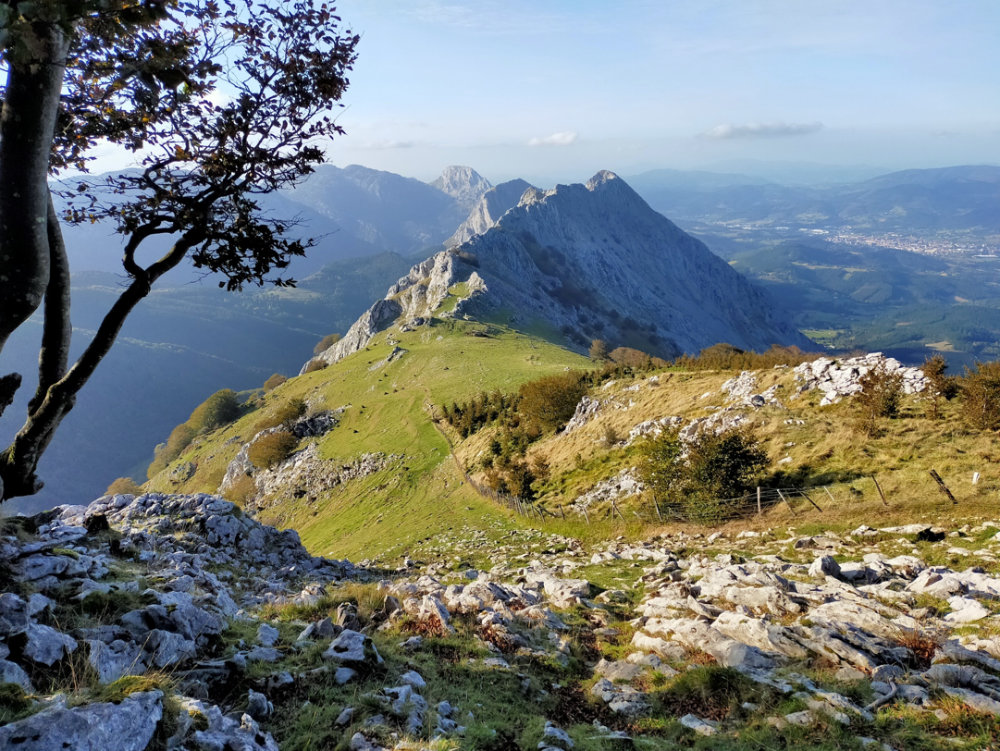 Paleoenvironmental and diagenetic signatures of a sub-volcanic intrusion into a carbonate platform
Paleoenvironmental and diagenetic signatures of a sub-volcanic intrusion into a carbonate platform
Started in September 2020
Defense the 17 january 2024
Funding: private contract (Modis)
Supervisor: Thomas Saucède (Biogéosciences) ; cosupervisor: Aurélien Virgone (R&D TOTAL S.A) ; technical supervisor: Christophe Durlet (Biogéosciences)
Abstract
This thesis is included in an understanding process of natural CO2 degassing phenomena in marine environment. Hydrothermal systems associated to sub-volcanic intrusions emplacement represent an open window towards these phenomena, particularly in modern systems. Although numerous, paleoenvironmental and diagenetic signatures of such systems remain poorly investigated in shallow marine domain, particularly in carbonate context. A sub-volcanic intrusion corresponds to an interruption of the magma rising up to few hundreds, or tens of meters just below the paleo-seafloor. This type of igneous body sometimes remains invisible on the paleo-seafloor, explaining why studies on the impact of such intrusions are rare. In other cases, hydrothermal cells with magmatic CO2-rich fluids can be induced by their emplacement. One of the aims of this thesis is to decrypt the impact of CO2-rich fluids of magmatic origin, on the genesis and diagenesis of carbonates in the open marine domain where the effects of dilution are important.
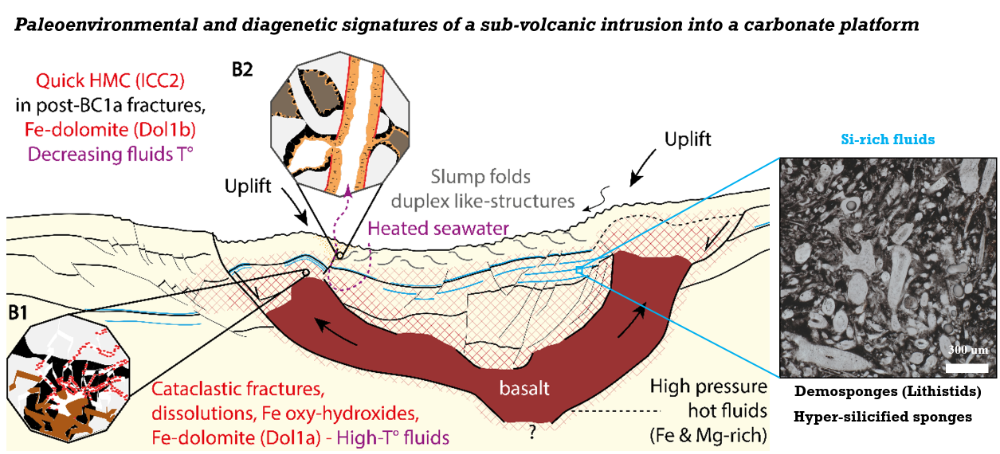 The Larrano igneous body crosscutting the urgonian carbonate platform (Lower Cretaceous) of Duranguesado located in the hyper-thinned Basque-Cantabrian Basin (Spain) has been the focal point of this thesis. A multi-proxy approach combining structural geology, sedimentology, palaeontology, diagenesis, geochemistry and U-Pb dating, has been necessary to decode signatures associated to this igneous body emplacement. This innovative methodology has led to requalify the magmatic body into a sub-volcanic intrusion. Moreover, a chronology of the sub-volcanic intrusion emplacement has been established thanks to this work. The results highlight the possibility of an influence on carbonate production and diagenesis induced by the sub-volcanic intrusion of Larrano. Three main elements make it possible to discriminate this relationship:
The Larrano igneous body crosscutting the urgonian carbonate platform (Lower Cretaceous) of Duranguesado located in the hyper-thinned Basque-Cantabrian Basin (Spain) has been the focal point of this thesis. A multi-proxy approach combining structural geology, sedimentology, palaeontology, diagenesis, geochemistry and U-Pb dating, has been necessary to decode signatures associated to this igneous body emplacement. This innovative methodology has led to requalify the magmatic body into a sub-volcanic intrusion. Moreover, a chronology of the sub-volcanic intrusion emplacement has been established thanks to this work. The results highlight the possibility of an influence on carbonate production and diagenesis induced by the sub-volcanic intrusion of Larrano. Three main elements make it possible to discriminate this relationship:
1) Paleontological, the spiculites described historically on the site include hyper-silicified sponge communities (Demosponges, Lithistids). Their development is local and atypical within the carbonate platform and seems to be controlled by massive inputs of dissolved silica (in proportion potentially up to 10 times higher that of the modern seawater). These siliceous influxes are compatible with exhalations of silica-rich fluids, common in magmatic domains.
2) Diagenetic, the eogenetic anomaly discovered at Larrano contains cataclastic fractures, early calcite dissolutions, Fe-rich coatings, ferroan saddle dolomite and magnesian calcite. These eogenetic phases essentially record the syn- and post-intrusive stages.
3) Structural, the numerous synsedimentary deformations discovered in the pre-intrusive series (duplex structures, slumps) surround doming and forced folding structures. These geometric and topographical manifestations are consistent with a magma ascent, inducing local deformations in the pre-intrusive series. These deformations are sealed by onlaps from the poorly deformed post-intrusive series.
These paleontological, diagenetic and structural signatures demonstrate the complexity linked to a sub-volcanic intrusion emplacement in a shallow marine carbonate domain. To go further on this thematic, a bibliographic synthesis on these complex interactions has been produced from around a hundred of ancient and current examples. From this work, 14 criteria have been identified, the reliability of which is discussed, to start building a tool (vade-mecum) helping to constrain a sub-volcanic intrusion emplacement within a carbonate platform.
To deal with the impact of natural CO2 degassing phenomena in the marine environment, this thesis focuses on a modern system (the Mayotte lagoon). Several similarities with the examples treated in this synthesis are observed, including a local influence of the order of kilometer and the preponderant presence of microbial communities and green algae in the seepage zones. These results open up a multidisciplinary field of study to understand the natural ability of marine systems to adapt to natural CO2 degassing phenomena. They can also be used as natural witnesses of a potential leak scenario during geological storage of anthropogenic CO2.
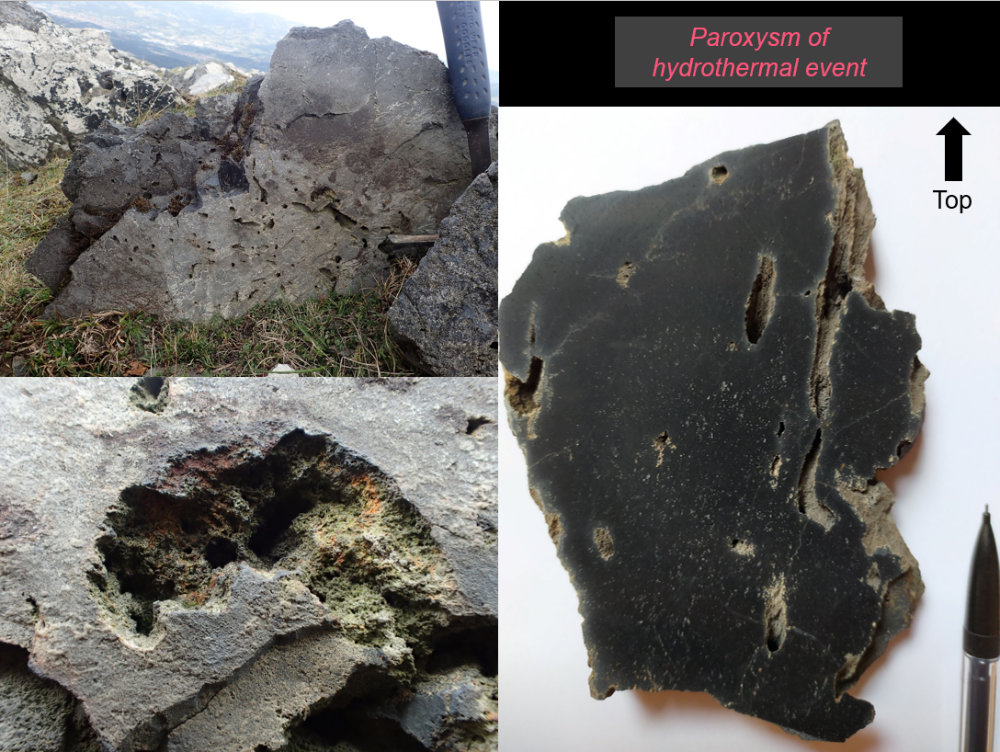 |
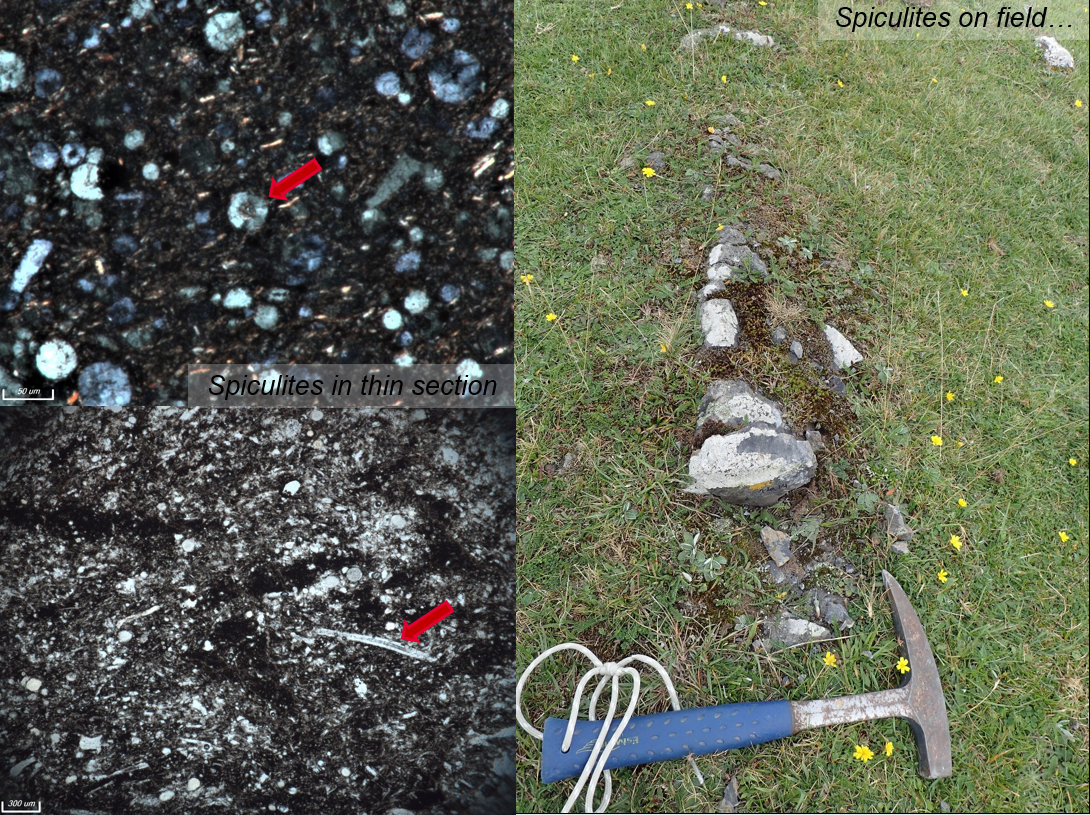 |
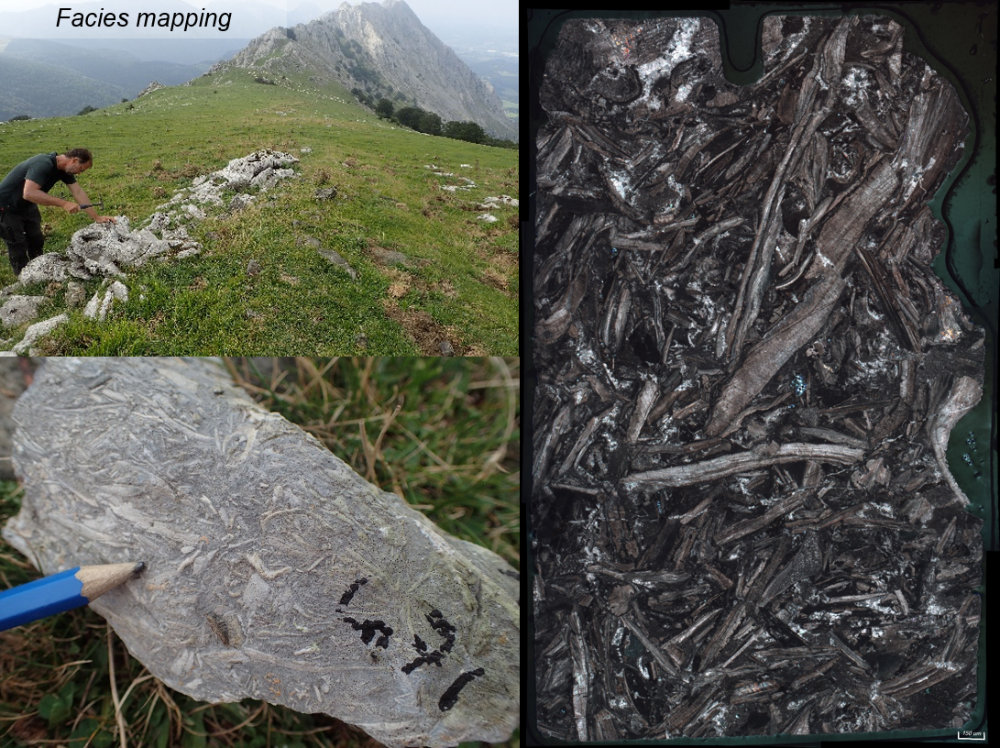 |
Keywords
paleoenvironment; early diagenesis; carbonate platform; sub-volcanic intrusion; hydrothermal system; Lower Cretaceous; Basque-Cantabrian Basin
Thesis advisory panel
Thomas Saucède (supervisor)
Aurélien Virgone (cosupervisor)
Christophe Durlet (cosupervisor)
Arnaud Brayard (Biogéosciences)
Stephan Jorry (Ifremer)
Jury
Elias Samankassou, université de Genève – reviewer
Benjamin Brigaud, université Paris-Saclay – reviewer
Emmanuelle Vennin, université de Bourgogne – examiner
Arantxa Bodego, université du Pays Basque – examiner
Thomas Saucède, université de Bourgogne – supervisor
Aurélien Virgone, TotalEnergies – cosupervisor
Christophe Durlet, université de Bourgogne – invited
- extrait:
- lien_externe:
- titre:
- Rôle des fluides hypogéens dans l’implantation et la croissance de vastes corps carbonatés sous-marins. Cas de la marge en hyper-extension de l’Aptien-Albien du bassin basco-cantabre
- date_de_debut_these:
- septembre 2020
- nom:
- Pascault
- date_de_debut_these_numerique:
- 202010
- kc_data:
- a:8:{i:0;s:0:"";s:4:"mode";s:0:"";s:3:"css";s:0:"";s:9:"max_width";s:0:"";s:7:"classes";s:0:"";s:9:"thumbnail";s:0:"";s:9:"collapsed";s:0:"";s:9:"optimized";s:0:"";}
- kc_raw_content:
 Paleoenvironmental and diagenetic signatures of a sub-volcanic intrusion into a carbonate platform
Paleoenvironmental and diagenetic signatures of a sub-volcanic intrusion into a carbonate platformStarted in September 2020
Defense the 17 january 2024
Funding: private contract (Modis)
Supervisor: Thomas Saucède (Biogéosciences) ; cosupervisor: Aurélien Virgone (R&D TOTAL S.A) ; technical supervisor: Christophe Durlet (Biogéosciences)
Abstract
This thesis is included in an understanding process of natural CO2 degassing phenomena in marine environment. Hydrothermal systems associated to sub-volcanic intrusions emplacement represent an open window towards these phenomena, particularly in modern systems. Although numerous, paleoenvironmental and diagenetic signatures of such systems remain poorly investigated in shallow marine domain, particularly in carbonate context. A sub-volcanic intrusion corresponds to an interruption of the magma rising up to few hundreds, or tens of meters just below the paleo-seafloor. This type of igneous body sometimes remains invisible on the paleo-seafloor, explaining why studies on the impact of such intrusions are rare. In other cases, hydrothermal cells with magmatic CO2-rich fluids can be induced by their emplacement. One of the aims of this thesis is to decrypt the impact of CO2-rich fluids of magmatic origin, on the genesis and diagenesis of carbonates in the open marine domain where the effects of dilution are important.
 The Larrano igneous body crosscutting the urgonian carbonate platform (Lower Cretaceous) of Duranguesado located in the hyper-thinned Basque-Cantabrian Basin (Spain) has been the focal point of this thesis. A multi-proxy approach combining structural geology, sedimentology, palaeontology, diagenesis, geochemistry and U-Pb dating, has been necessary to decode signatures associated to this igneous body emplacement. This innovative methodology has led to requalify the magmatic body into a sub-volcanic intrusion. Moreover, a chronology of the sub-volcanic intrusion emplacement has been established thanks to this work. The results highlight the possibility of an influence on carbonate production and diagenesis induced by the sub-volcanic intrusion of Larrano. Three main elements make it possible to discriminate this relationship:
The Larrano igneous body crosscutting the urgonian carbonate platform (Lower Cretaceous) of Duranguesado located in the hyper-thinned Basque-Cantabrian Basin (Spain) has been the focal point of this thesis. A multi-proxy approach combining structural geology, sedimentology, palaeontology, diagenesis, geochemistry and U-Pb dating, has been necessary to decode signatures associated to this igneous body emplacement. This innovative methodology has led to requalify the magmatic body into a sub-volcanic intrusion. Moreover, a chronology of the sub-volcanic intrusion emplacement has been established thanks to this work. The results highlight the possibility of an influence on carbonate production and diagenesis induced by the sub-volcanic intrusion of Larrano. Three main elements make it possible to discriminate this relationship:
1) Paleontological, the spiculites described historically on the site include hyper-silicified sponge communities (Demosponges, Lithistids). Their development is local and atypical within the carbonate platform and seems to be controlled by massive inputs of dissolved silica (in proportion potentially up to 10 times higher that of the modern seawater). These siliceous influxes are compatible with exhalations of silica-rich fluids, common in magmatic domains.
2) Diagenetic, the eogenetic anomaly discovered at Larrano contains cataclastic fractures, early calcite dissolutions, Fe-rich coatings, ferroan saddle dolomite and magnesian calcite. These eogenetic phases essentially record the syn- and post-intrusive stages.
3) Structural, the numerous synsedimentary deformations discovered in the pre-intrusive series (duplex structures, slumps) surround doming and forced folding structures. These geometric and topographical manifestations are consistent with a magma ascent, inducing local deformations in the pre-intrusive series. These deformations are sealed by onlaps from the poorly deformed post-intrusive series.These paleontological, diagenetic and structural signatures demonstrate the complexity linked to a sub-volcanic intrusion emplacement in a shallow marine carbonate domain. To go further on this thematic, a bibliographic synthesis on these complex interactions has been produced from around a hundred of ancient and current examples. From this work, 14 criteria have been identified, the reliability of which is discussed, to start building a tool (vade-mecum) helping to constrain a sub-volcanic intrusion emplacement within a carbonate platform.
To deal with the impact of natural CO2 degassing phenomena in the marine environment, this thesis focuses on a modern system (the Mayotte lagoon). Several similarities with the examples treated in this synthesis are observed, including a local influence of the order of kilometer and the preponderant presence of microbial communities and green algae in the seepage zones. These results open up a multidisciplinary field of study to understand the natural ability of marine systems to adapt to natural CO2 degassing phenomena. They can also be used as natural witnesses of a potential leak scenario during geological storage of anthropogenic CO2.



Keywords
paleoenvironment; early diagenesis; carbonate platform; sub-volcanic intrusion; hydrothermal system; Lower Cretaceous; Basque-Cantabrian Basin
Thesis advisory panel
Thomas Saucède (supervisor)
Aurélien Virgone (cosupervisor)
Christophe Durlet (cosupervisor)
Arnaud Brayard (Biogéosciences)
Stephan Jorry (Ifremer)Jury
Elias Samankassou, université de Genève - reviewer
Benjamin Brigaud, université Paris-Saclay - reviewer
Emmanuelle Vennin, université de Bourgogne - examiner
Arantxa Bodego, université du Pays Basque - examiner
Thomas Saucède, université de Bourgogne - supervisor
Aurélien Virgone, TotalEnergies - cosupervisor
Christophe Durlet, université de Bourgogne - invited
